
Belgrave and Birstall railway station
Encyclopedia
Belgrave and Birstall railway station was a railway station opened by the Great Central Railway
in 1899
. In 1991 Leicester North railway station was opened immediately to the south of Belgrave and Birstall railway station by the preserved Great Central
heritage railway
and is representative of the 1960s when the line was under control of British Railways Midland Region
. It is currently the southern terminus of the railway. It served the villages of Belgrave
and Birstall
in Leicestershire
.
Leicester North station consists of a long main platform along the western side of the line and short bay platform on the east. These are joined by a concourse, and between them a simple run-round loop with short spur-siding arrangement allows a slight flexibility in train operation, although services are usually operated under 'One engine in steam' principles. A single short building provides basic services, including a booking office and refreshment servery, a waiting room, and toilet facilities (see history section).
Still clearly visible at the station is the walled recess in which sat the signalbox and lamp room, as well as the bricked-up entrance archway of the old Belgrave and Birstall station.
The current bufferstops fall at approximately the 100.75 milepost. Immediately south of here, the formation has been removed to allow the construction of the Leicester Western Distributor road, although a footbridge running close to the alignment of the former trackbed carries pedestrians to Thurcaston road, over which the line used to pass. The bridge here was removed in September 1979 although the southern abutment remains.
A signal box and a lamp hut were provided to the south east of the station and further afield a station master's house was constructed. Since this house further was from the station than on other London Extension stations, the platform had an 'extra' building to provide the Station Master
with a private office. Built within the tight constraints of a cutting, Belgrave and Birstall was the only rural station on the London Extension to have no goods facilities.
Vandalism was an ever-present problem for the B-BAG. By summer 1971 police had been summoned on a number of occasions to the station, which was reported to be in a "very sad state". As late as spring 1972 the action group was not yet allowed access to the site to repair vandalism, and buildings were in a dangerous condition which would require "substantial rebuilding".
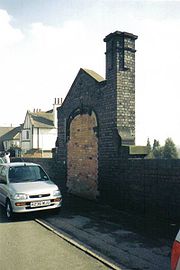 Restoration work at the station began in June 1972, and considerable efforts were made in making some of the buildings safe. Other buildings required more substantive work.
Restoration work at the station began in June 1972, and considerable efforts were made in making some of the buildings safe. Other buildings required more substantive work.
Due to increasing financial pressures placed upon the Main Line Steam Trust (as the MLPG had become) by British Rail, in 1973, one of the two tracks between Belgrave and Birstall and was lifted, leaving only a single track in place. In 1976 the remaining track would was lifted, leaving no rail access to Belgrave and Birstall station.
Ever present vandalism continued to leave the station buildings in a dangerous state, and the B-BAG reluctantly decided to demolish three of the station buildings - the Gentleman's toilets; Station Master's Office; and Ladies' Room and General Waiting Room buildings were removed on 18 and 19 June 1977. The Booking Office; Stairs; and "tunnel rooms" were bricked up for later use The remaining structures were removed in 1985, leaving only the platform and bricked up road-level entrance. The entrance archway remains to this day, though bricked up, as can be seen on recent photographs.
and Rothley railway station
by the MLST, a new operating company had been formed - Great Central Railway (1976) Ltd. (GCR76). This company had subsequently obtained a Light Railway Order
(LRO) to allow the heritage line to operate its own trains without British Rail supervision. The powers granted by GCR76s LRO had encompassed the MLPG goal of preserving the line as far as Birstall, and as such GCR76 had the legal power to lay new track from its Rothley rail-head to the platform at Birstall. By summer 1984 it was felt that the railway's finances were now viable enough to allow what was to become known as The Birstall Extension. A favourable preliminary survey of structures between Rothley and Birstall gave the board of directors confidence enough to announce officially in Autumn 1984 that the railway would be extending to Belgrave and Birstall.
Work on the extension had started to clear vegetation that had grown on the track bed. More serious problems to be handled were the encroachment of road improvements. To the immediate south of the station, a new road from Mowmacre Hill to Redhill roundabout would cut through the railway's embankment. Leicester City Council
agreed to build an access road (eventually named The Sidings) to the railway from this new road, later to be known as the Leicester Western Distributor road. A mile to the north of the station, the new Leicester by-pass was planned to be built crossing the line. This effectively set a deadline of 1986 to build the first mile of track, since the new bridge was to add greatly to the cost of the by-pass. It was suggested to the railway that if there was no railway line to cross by 1986, it would be cheaper to have the LRO to Birstall rescinded on the grounds that the company had no plans to go there.
By Spring 1985, discussion on the design of the new station to replace Belgrave and Birstall had begun. The appeal to fund the Birstall Extension was officially launched on 8 June 1985 by H.R.H. The Duke of Gloucester, who inserted a ceremonial chromium plated bolt into the trackwork at Rothley. With Manpower Services Commission
assisted work continuing on the extension, design ideas for the new station at Birstall all incorporated the original platform and bridge as part of the scheme, although schemes where the platform would be extended to the north of the road bridge were formally scrapped. By late 1987, however, it seemed that through co-funding via Leicester City, who planned to build a museum 'Industrial village' adjacent to the site, a wholly new station to the south of Belgrave and Birstall would be built, requiring the removal of the existing platform.
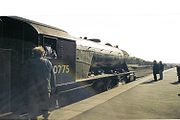
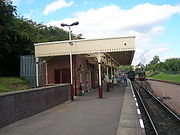
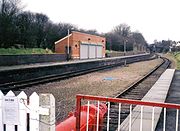 The Birstall Extension finally arrived at the bare platform of Belgrave and Birstall station during spring 1988. Only sufficient track was laid against the existing platform to enable its demolition. Delays in completing the road from the new Leicester Western Distributor Road caused further delays by preventing the delivery of ballast for packing. Feasibility studies for the industrial museum were put on hold, which in turn required the retainment of the island platform for longer than planned. In early 1989, plans were submitted for extending track from the limit of the existing LRO into the land under jurisdiction of Leicester City Council. The eventual outcome was that Charnwood Borough Council (the GCRs landlord up to Birstall) and Leicester City Council came to an arrangement for a slight extension of the railway into Leicester, and a new LRO was submitted before Parliament for a new Leicester North Station.
The Birstall Extension finally arrived at the bare platform of Belgrave and Birstall station during spring 1988. Only sufficient track was laid against the existing platform to enable its demolition. Delays in completing the road from the new Leicester Western Distributor Road caused further delays by preventing the delivery of ballast for packing. Feasibility studies for the industrial museum were put on hold, which in turn required the retainment of the island platform for longer than planned. In early 1989, plans were submitted for extending track from the limit of the existing LRO into the land under jurisdiction of Leicester City Council. The eventual outcome was that Charnwood Borough Council (the GCRs landlord up to Birstall) and Leicester City Council came to an arrangement for a slight extension of the railway into Leicester, and a new LRO was submitted before Parliament for a new Leicester North Station.
Throughout 1989, ballast was brought in and deposited on the Belgrave and Birstall platform for loading into rail ballast wagons, which then ferried the material along the extension to enable the new track to be correctly packed and aligned so that it would be fit for passenger traffic. All this allowed the Birstall Extension to be officially opened on Thursday 15 November 1990. GCR locomotive No.506 "Butler Henderson" hauled a train of MLST directors and local civic dignitaries from Loughborough Central to Rothley, where they changed to a specially fitted push-pull train for the return ride to Belgrave and Birstall. Regular passenger services, push-pull operated, soon resumed to a point just short of the old platform.
Work commenced on removing the old platform and building the new Leicester North station to the south. On 5 July 1991 the new station was opening by the Rt.Hon. Michael Heseltine MP, flanked by the replica of Stephenson's Rocket and No.35005 Canadian Pacific, each running into its own platform at Leicester North. The inclusion of a run-round loop at Leicester North removed the need for push-pull operation between Birstall and Rothley and through services from Loughborough Central could begin. The buffers set into the end of the platform were donated by British Rail and originate from London
's Marylebone station, the terminus of the Great Central Railway's London Extension. Due to the lack of station buildings, a carriage was regularly used to act as a ticket office and kiosk.
Full planning permission was granted on 7 October 1992 for the construction of the main building, concourse and overall roof at Leicester North station., however after it was discovered that a high-pressure water main ran through the site the plans were dropped.
Development of the station since since opening has been slow due to the return of vandalism. The problems of travellers camping on the small car park at the top of "The Sidings" access road was remedied in 1998 by the installation of a lockable gate.
In late 1998, planning permission was granted for a modest construction on the down platform, intended as waiting room, booking office and toilet. Permission was also granted for a canopy, however it was not intended to erect this at the same time as the building, the whole approach for Leicester North development having switched to a modular approach. Following a £30,000 bequest to the MLST by the Edith Murphy Trust, only £20,000 remained to be raised at the time the drawings of the new building were first published The ceremonial "Cutting of the first sod" by the Countess of Lanesborough took place on 9 March 1999 as part of the railway's cetenary celebrations, with contractors beginning work on the foundations on 19 April and was completed by late June.
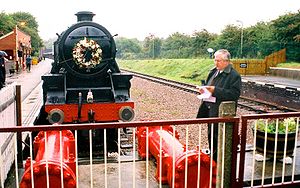 Construction progress was hindered by repeat vandalism, with the toppling of freshly laid brickwork on several occasions. Brickwork was complete to roof level by late January 2000, with a variety of fitting-out, including connection to services and the installation of roller-shutter doors, plastering, and decoration, taking place throughout mid 2000. Shortly after, however, the contractor was unable to continue work, and further progress would not take place until July 2001 after a new contractor was assigned to complete the building and tarmac the platform. The building opened for public use soon after.
Construction progress was hindered by repeat vandalism, with the toppling of freshly laid brickwork on several occasions. Brickwork was complete to roof level by late January 2000, with a variety of fitting-out, including connection to services and the installation of roller-shutter doors, plastering, and decoration, taking place throughout mid 2000. Shortly after, however, the contractor was unable to continue work, and further progress would not take place until July 2001 after a new contractor was assigned to complete the building and tarmac the platform. The building opened for public use soon after.
No substantial further development of the station has taken place since the opening of the waiting rooms, although a variety of small additions including picnic tables have been added to the station in recent years. A small canopy (pictured above) was built around the station building. An ambitious set of features was originally planned, including a second engine shed, a turntable, garden and another platform.
Over the weekend of 2 and 3 September 2006, Leicester North hosted the commemorative speeches marking the 40th anniversary of the closure of the Great Central as a through route from Sheffield to London.
Great Central Railway
The Great Central Railway was a railway company in England which came into being when the Manchester, Sheffield and Lincolnshire Railway changed its name in 1897 in anticipation of the opening in 1899 of its London Extension . On 1 January 1923, it was grouped into the London and North Eastern...
in 1899
1899 in rail transport
- February events :* February 9 – Minneapolis and St. Louis Railway purchases the Minneapolis, New Ulm and Southern.- March events :* March 12 – Southern Railway in the United States inaugurates the Piedmont Limited passenger train service....
. In 1991 Leicester North railway station was opened immediately to the south of Belgrave and Birstall railway station by the preserved Great Central
Great Central Railway (preserved)
The Great Central Railway is a heritage railway split into two adjacent sections, one in Leicestershire and the other Nottinghamshire.The Leicestershire section is currently Britain's only double track mainline heritage railway, with of working double track, period signalling, locomotives and...
heritage railway
Heritage railway
thumb|right|the Historical [[Khyber train safari|Khyber Railway]] goes through the [[Khyber Pass]], [[Pakistan]]A heritage railway , preserved railway , tourist railway , or tourist railroad is a railway that is run as a tourist attraction, in some cases by volunteers, and...
and is representative of the 1960s when the line was under control of British Railways Midland Region
London Midland Region of British Railways
The London Midland Region was one of the six regions created on the formation of the nationalised British Railways and consisted of ex-London, Midland and Scottish Railway lines in England and Wales. The region was managed first from buildings adjacent to Euston Station and later from Stanier...
. It is currently the southern terminus of the railway. It served the villages of Belgrave
Belgrave, Leicestershire
Belgrave is an electoral ward and administrative division of the city of Leicester, England, consisting of the Leicester suburb of Belgrave in its entirety....
and Birstall
Birstall, Leicestershire
Birstall is a large village and civil parish within the Charnwood borough of Leicestershire, England. It is three miles north of the Leicester city centre and is part of the wider Leicester Urban Area....
in Leicestershire
Leicestershire
Leicestershire is a landlocked county in the English Midlands. It takes its name from the heavily populated City of Leicester, traditionally its administrative centre, although the City of Leicester unitary authority is today administered separately from the rest of Leicestershire...
.
Route description
Curving south of milepost 99, the line continues to climb at the ruling 1 in 176 gradient (10 yards per mile). After passing over an original farm occupation crossing (structure 359), it passes under the new Leicester bypass road (see history section) before straightening and leveling out as far as milepost 100 (shortly after overbridge 360). Turning sharply to the west, the railway falls as it approaches the outskirts of Leicester. Shortly after passing under the redundant bridge 361 (blocked off on one side), an ancient right-of-way crosses the trackbed on the level, though only for pedestrian traffic. The final descent into Leicester North station first cuts deeply beneath Park Road (bridge 362) before the formation widens to accommodate the former running lines to pass between each of the Belgrave and Birstall station bridge arches.Leicester North station consists of a long main platform along the western side of the line and short bay platform on the east. These are joined by a concourse, and between them a simple run-round loop with short spur-siding arrangement allows a slight flexibility in train operation, although services are usually operated under 'One engine in steam' principles. A single short building provides basic services, including a booking office and refreshment servery, a waiting room, and toilet facilities (see history section).
Still clearly visible at the station is the walled recess in which sat the signalbox and lamp room, as well as the bricked-up entrance archway of the old Belgrave and Birstall station.
The current bufferstops fall at approximately the 100.75 milepost. Immediately south of here, the formation has been removed to allow the construction of the Leicester Western Distributor road, although a footbridge running close to the alignment of the former trackbed carries pedestrians to Thurcaston road, over which the line used to pass. The bridge here was removed in September 1979 although the southern abutment remains.
Current services
- Heritage steam and diesel train services operate to Leicester North from every weekend and bank holidayBank HolidayA bank holiday is a public holiday in the United Kingdom or a colloquialism for public holiday in Ireland. There is no automatic right to time off on these days, although the majority of the population is granted time off work or extra pay for working on these days, depending on their contract...
of the year. - Additional services operate on selected weekdays throughout the year.
- During the summer time there is a connection to an open-topped tour bus that runs from the station to LeicesterLeicesterLeicester is a city and unitary authority in the East Midlands of England, and the county town of Leicestershire. The city lies on the River Soar and at the edge of the National Forest...
City Centre and the National Space CentreNational Space CentreThe National Space Centre is one of the United Kingdom's leading visitor attractions that is devoted to space science and astronomy. It is located in the city of Leicester, England, next to the River Soar on the A6.-History:...
, amongst other tourist destinations in and around Leicester.
Belgrave and Birstall station
Belgrave and Birstall station was built as a part of the Great Central Railway's London Extension and opened to passengers on March 15, 1899. The station was built to the standard London Extension country station pattern of a single large 'island' platform between the two running lines, on which stood the station buildings, including ticket office and waiting rooms. Access was made by descending a flight of stairs from a road bridge (structure number 363) that crossed the line.A signal box and a lamp hut were provided to the south east of the station and further afield a station master's house was constructed. Since this house further was from the station than on other London Extension stations, the platform had an 'extra' building to provide the Station Master
Station master
The station master was the person in charge of railway stations, in the United Kingdom and some other countries, before the modern age. He would manage the other station employees and would have responsibility for safety and the efficient running of the station...
with a private office. Built within the tight constraints of a cutting, Belgrave and Birstall was the only rural station on the London Extension to have no goods facilities.
After closure
Belgrave and Birstall station closed on 1 March 1963 along with most other local stations on the London Extension. A group of local enthusiasts formed the Belgrave and Birstall Action Group (B-BAG) in the late 1960s with the aim of restoring the station. When the Main Line Preservation Group (MLPG) formed in 1968 with the aim of preserving a section of the London Extension for the use of steam trains, the B-BAG effectively merged to become a small sub-group of the MLPG.Vandalism was an ever-present problem for the B-BAG. By summer 1971 police had been summoned on a number of occasions to the station, which was reported to be in a "very sad state". As late as spring 1972 the action group was not yet allowed access to the site to repair vandalism, and buildings were in a dangerous condition which would require "substantial rebuilding".

Due to increasing financial pressures placed upon the Main Line Steam Trust (as the MLPG had become) by British Rail, in 1973, one of the two tracks between Belgrave and Birstall and was lifted, leaving only a single track in place. In 1976 the remaining track would was lifted, leaving no rail access to Belgrave and Birstall station.
Ever present vandalism continued to leave the station buildings in a dangerous state, and the B-BAG reluctantly decided to demolish three of the station buildings - the Gentleman's toilets; Station Master's Office; and Ladies' Room and General Waiting Room buildings were removed on 18 and 19 June 1977. The Booking Office; Stairs; and "tunnel rooms" were bricked up for later use The remaining structures were removed in 1985, leaving only the platform and bricked up road-level entrance. The entrance archway remains to this day, though bricked up, as can be seen on recent photographs.
The Birstall Extension
Following the restoration of heritage train services between Loughborough Central railway stationLoughborough Central railway station
Loughborough Central Station is a railway station on the Great Central Railway and the Great Central Railway serving Loughborough....
and Rothley railway station
Rothley railway station
Rothley railway station is a heritage railway station on the preserved section of the Great Central Railway's London Extension. Built to the standard island platform pattern of country stations on the line, it originally opened on 15 March 1899 and has been restored to late Edwardian era...
by the MLST, a new operating company had been formed - Great Central Railway (1976) Ltd. (GCR76). This company had subsequently obtained a Light Railway Order
Light Railways Act 1896
The Light Railways Act 1896 was an Act of the Parliament of the United Kingdom of Great Britain and Ireland . Before the Act each new railway line built in the country required a specific Act of Parliament to be obtained by the company that wished to construct it, which greatly added to the cost...
(LRO) to allow the heritage line to operate its own trains without British Rail supervision. The powers granted by GCR76s LRO had encompassed the MLPG goal of preserving the line as far as Birstall, and as such GCR76 had the legal power to lay new track from its Rothley rail-head to the platform at Birstall. By summer 1984 it was felt that the railway's finances were now viable enough to allow what was to become known as The Birstall Extension. A favourable preliminary survey of structures between Rothley and Birstall gave the board of directors confidence enough to announce officially in Autumn 1984 that the railway would be extending to Belgrave and Birstall.
Work on the extension had started to clear vegetation that had grown on the track bed. More serious problems to be handled were the encroachment of road improvements. To the immediate south of the station, a new road from Mowmacre Hill to Redhill roundabout would cut through the railway's embankment. Leicester City Council
Leicester City Council
Leicester City Council is a unitary authority responsible for local government in the city of Leicester, England. It consists of 54 councillors, representing 22 wards in the city, overseen by a directly elected mayor. It is currently controlled by the Labour Party and has been led by Mayor Sir...
agreed to build an access road (eventually named The Sidings) to the railway from this new road, later to be known as the Leicester Western Distributor road. A mile to the north of the station, the new Leicester by-pass was planned to be built crossing the line. This effectively set a deadline of 1986 to build the first mile of track, since the new bridge was to add greatly to the cost of the by-pass. It was suggested to the railway that if there was no railway line to cross by 1986, it would be cheaper to have the LRO to Birstall rescinded on the grounds that the company had no plans to go there.
By Spring 1985, discussion on the design of the new station to replace Belgrave and Birstall had begun. The appeal to fund the Birstall Extension was officially launched on 8 June 1985 by H.R.H. The Duke of Gloucester, who inserted a ceremonial chromium plated bolt into the trackwork at Rothley. With Manpower Services Commission
Manpower Services Commission
The Manpower Services Commission was a non-departmental public body of the Department of Employment Group in the United Kingdom created by Edward Heath's Conservative Government in 1973. The MSC had a remit to co-ordinate employment and training services in the UK through a ten-member commission...
assisted work continuing on the extension, design ideas for the new station at Birstall all incorporated the original platform and bridge as part of the scheme, although schemes where the platform would be extended to the north of the road bridge were formally scrapped. By late 1987, however, it seemed that through co-funding via Leicester City, who planned to build a museum 'Industrial village' adjacent to the site, a wholly new station to the south of Belgrave and Birstall would be built, requiring the removal of the existing platform.
Leicester North station



Throughout 1989, ballast was brought in and deposited on the Belgrave and Birstall platform for loading into rail ballast wagons, which then ferried the material along the extension to enable the new track to be correctly packed and aligned so that it would be fit for passenger traffic. All this allowed the Birstall Extension to be officially opened on Thursday 15 November 1990. GCR locomotive No.506 "Butler Henderson" hauled a train of MLST directors and local civic dignitaries from Loughborough Central to Rothley, where they changed to a specially fitted push-pull train for the return ride to Belgrave and Birstall. Regular passenger services, push-pull operated, soon resumed to a point just short of the old platform.
Work commenced on removing the old platform and building the new Leicester North station to the south. On 5 July 1991 the new station was opening by the Rt.Hon. Michael Heseltine MP, flanked by the replica of Stephenson's Rocket and No.35005 Canadian Pacific, each running into its own platform at Leicester North. The inclusion of a run-round loop at Leicester North removed the need for push-pull operation between Birstall and Rothley and through services from Loughborough Central could begin. The buffers set into the end of the platform were donated by British Rail and originate from London
London
London is the capital city of :England and the :United Kingdom, the largest metropolitan area in the United Kingdom, and the largest urban zone in the European Union by most measures. Located on the River Thames, London has been a major settlement for two millennia, its history going back to its...
's Marylebone station, the terminus of the Great Central Railway's London Extension. Due to the lack of station buildings, a carriage was regularly used to act as a ticket office and kiosk.
Full planning permission was granted on 7 October 1992 for the construction of the main building, concourse and overall roof at Leicester North station., however after it was discovered that a high-pressure water main ran through the site the plans were dropped.
Development of the station since since opening has been slow due to the return of vandalism. The problems of travellers camping on the small car park at the top of "The Sidings" access road was remedied in 1998 by the installation of a lockable gate.
In late 1998, planning permission was granted for a modest construction on the down platform, intended as waiting room, booking office and toilet. Permission was also granted for a canopy, however it was not intended to erect this at the same time as the building, the whole approach for Leicester North development having switched to a modular approach. Following a £30,000 bequest to the MLST by the Edith Murphy Trust, only £20,000 remained to be raised at the time the drawings of the new building were first published The ceremonial "Cutting of the first sod" by the Countess of Lanesborough took place on 9 March 1999 as part of the railway's cetenary celebrations, with contractors beginning work on the foundations on 19 April and was completed by late June.

No substantial further development of the station has taken place since the opening of the waiting rooms, although a variety of small additions including picnic tables have been added to the station in recent years. A small canopy (pictured above) was built around the station building. An ambitious set of features was originally planned, including a second engine shed, a turntable, garden and another platform.
Over the weekend of 2 and 3 September 2006, Leicester North hosted the commemorative speeches marking the 40th anniversary of the closure of the Great Central as a through route from Sheffield to London.

